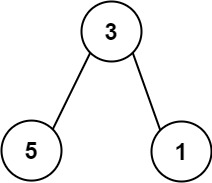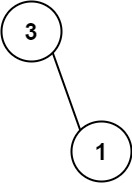| ID | Title | Difficulty | |
|---|---|---|---|
| Loading... | |||
666. Path Sum IV
Medium
LeetCode
Array, Tree, Depth-First Search, Binary Tree
Problem
If the depth of a tree is smaller than 5, then this tree can be represented by an array of three-digit integers. For each integer in this array:
- The hundreds digit represents the depth d of this node where 1 <= d <= 4.
- The tens digit represents the position p of this node in the level it belongs to where 1 <= p <= 8. The position is the same as that in a full binary tree.
- The units digit represents the value v of this node where 0 <= v <= 9.
Given an array of ascending three-digit integers nums representing a binary tree with a depth smaller than 5, return the sum of all paths from the root towards the leaves.
It is guaranteed that the given array represents a valid connected binary tree.
Example 1:

Input: nums = [113,215,221]
Output: 12
Explanation: The tree that the list represents is shown.
The path sum is (3 + 5) + (3 + 1) = 12.
Example 2:

Input: nums = [113,221]
Output: 4
Explanation: The tree that the list represents is shown.
The path sum is (3 + 1) = 4.
Constraints:
- 1 <= nums.length <= 15
- 110 <= nums[i] <= 489
- nums represents a valid binary tree with depth less than 5.
Code
class Solution {
public int pathSum(int[] nums) {
int[][] arr = new int[5][8];
for (int num : nums) {
int depth = num / 100;
int index = (num / 10) % 10 - 1;
int value = num % 10;
arr[depth][index] = arr[depth - 1][index / 2] + value;
}
int res = 0;
for (int i = 1; i < 5; i++) {
for (int j = 0; j < 8; j++) {
if (i == 4 || (arr[i][j] != 0 && arr[i + 1][j * 2] == 0 && arr[i + 1][j * 2 + 1] == 0)){
res += arr[i][j];
}
}
}
return res;
}
}
按 <- 键看上一题!
665. Non-decreasing Array
按 -> 键看下一题!
667. Beautiful Arrangement II


